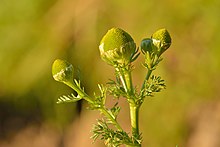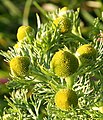| Matricaria discoidea | |
|---|---|

| |
| Pineappleweed | |
| Scientific classification | |
| Kingdom: | Plantae |
| Clade: | Tracheophytes |
| Clade: | Angiosperms |
| Clade: | Eudicots |
| Clade: | Asterids |
| Order: | Asterales |
| Family: | Asteraceae |
| Genus: | Matricaria |
| Species: | M. discoidea
|
| Binomial name | |
| Matricaria discoidea | |
| Synonyms | |
|
Artemisia matricarioides auct. | |
Matricaria discoidea, commonly known as pineappleweed,[3] wild chamomile, disc mayweed, and rayless mayweed, is an annual plant native to North America and introduced to Eurasia where it grows as a common herb of fields, gardens, and roadsides.[4] It is in the daisy family Asteraceae. The flowers exude a chamomile/pineapple aroma when crushed. They are edible and have been used in salads (although they may become bitter by the time the plant blooms) and to make herbal tea.
Description[edit]
The flower head or pseudanthium is cone-shaped, composed of densely packed yellowish-green corollas, and lacking ray-florets. The leaves are pinnately dissected and sweet-scented when crushed. The plant grows 2 to 16 in (5.1 to 40.6 cm) high. Flowerheads are produced from March to September.
Distribution and habitat[edit]
The plant grows well in disturbed areas, especially those with poor, compacted soil. It can be seen blooming on footpaths, roadsides, and similar places in spring and early summer. It is native to North America, from central Alaska south to California and Texas and east to Nova Scotia and Newfoundland.[5] It is also native to Greenland.[5] Though other sources, like the Flora of North America, assert that it is only native to the Pacific Northwest and while noting that NatureServe incorrectly list it as introduced to North America.[6]
It has been introduced widely in the northern hemisphere[5] and is common and naturalized throughout Britain where it is one of the fastest-spreading plants in the 20th century.[7][8]
Uses[edit]
The greens can be washed and eaten, and both the flowers and the whole plant can be steeped to make tea,[9] described as "excellent" by one field guide.[10]
Gallery[edit]
-
The pinnately dissected leaves are sweet-scented when crushed
References[edit]
- ^ USDA, NRCS (n.d.). "Matricaria discoidea". The PLANTS Database (plants.usda.gov). Greensboro, North Carolina: National Plant Data Team. Retrieved 2008-06-14.
- ^ Germplasm Resources Information Network (GRIN) (2005-09-07). "Taxon: Matricaria discoidea DC". Taxonomy for Plants. USDA, ARS, National Genetic Resources Program, National Germplasm Resources Laboratory, Beltsville, Maryland. Archived from the original on 2008-04-22. Retrieved 2008-06-14.
- ^ BSBI List 2007 (xls). Botanical Society of Britain and Ireland. Archived from the original (xls) on 2015-06-26. Retrieved 2014-10-17.
- ^ "Pineapple Mayweed". NatureGate.
- ^ a b c "Matricaria discoidea DC". Plants of the World Online. Royal Botanic Gardens, Kew. Retrieved 21 February 2024.
- ^ Brouillet, Luc (5 November 2020). "Matricaria discoidea - FNA". Flora of North America. Retrieved 21 February 2024.
- ^ P.A. Stroh; T. A. Humphrey; R.J. Burkmar; O.L. Pescott; D.B. Roy; K.J. Walker (eds.). "Matricaria discoidea DC". BSBI Online Plant Atlas 2020. Botanical Society of Britain and Ireland. Retrieved 21 February 2024.
- ^ The Wildlife Trusts, "Pineappleweed" http://www.wildlifetrusts.org/species/pineappleweed
- ^ Nyerges, Christopher (2017). Foraging Washington: Finding, Identifying, and Preparing Edible Wild Foods. Guilford, CT: Falcon Guides. ISBN 978-1-4930-2534-3. OCLC 965922681.
- ^ Benoliel, Doug (2011). Northwest Foraging: The Classic Guide to Edible Plants of the Pacific Northwest (Rev. and updated ed.). Seattle, WA: Skipstone. p. 123. ISBN 978-1-59485-366-1. OCLC 668195076.
External links[edit]
- USDA Plants Profile for Matricaria discoidea (Disc mayweed, Pineapple weed)
- Jepson Manual treatment: for Chamomilla suaveolens —Matricaria discoidea
- University of Michigan Native American Ethnobotany — Matricaria discoidea
- Pineapple weed - Matricaria discoidea
- Robbins, W. W., Margaret K. Bellue, and Walter S. Ball. 1970. Weeds of California. Documents and Publications, Sacramento. 547 p.
- Gregory L. Tilford. 1997. Edible and Medicinal Plants of the West. Mountain Press Publishing Company, Missoula. 110 p.
- University of California-Davis, Statewide Integrated Pest Management Program — 'Pineapple weed'
- "Matricaria matricarioides". Plants for a Future.
- Matricaria discoidea in the CalPhotos photo database, University of California, Berkeley





